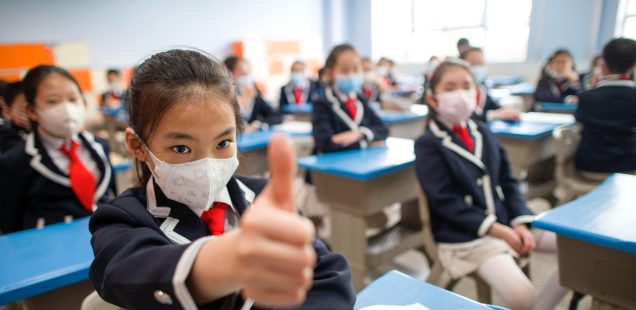
Virtually Anything
So Omicron has arrived with a vengeance and people have started using the dreaded “R” and “D” words again. They have started to ask the fateful question. What do you think, Linda? With so many people getting sick, don’t you think it would be better to return to remote-learning?
“Noooooo!” I cry. I do not think it would be better to return to remote learning even though as I write this many teachers and students are once again out with Covid. I wish that weren’t so, but the fact is that I am ready to chance getting Covid rather than going remote again. Remote learning was the most soul-killing experience I’ve ever had as a teacher. Virtually anything is better than that.
I expect most teachers feel the same. They want to teach their students face-to-face and not on a computer. They want to watch their fourth and fifth graders give live presentations or their kindergarteners examine small objects with magnifying glasses, delighting in the everyday mysteries of their world. Such moments are why we all became teachers in the first place and we want to keep experiencing them, but we have struggled to experience them since the advent of Covid. First, we were home and then we were hybrid and even these past few months back in school have been hard although hard in a different way.
Take teacher caseloads, for example. This year as well as last, I have been responsible for sixty students. There is no point in complaining about this caseload because it is not an unusual caseload in my district. My ESL colleagues at other schools have the same number of students. Some of them have more. How do we manage these large caseloads? We take larger groups than we should and we take them less frequently. Does the district know this is happening? They have to know. So why don’t they hire more people? Well, for one thing, it’s hard to find teachers at the moment. It’s hard to find anyone who wants to go into schools full of germy children. But in our district the decision not to hire more teachers has actually had as much to do with the cost-cutting program our district embarked upon prior to the pandemic as it has with the difficulty of finding willing applicants. Teaching staff has been down-sized. Class sizes have been increased.
Increased class sizes, I hear you say, but what about social distancing?
What about it? It was sort-of possible when we were hybrid and half of our students were at home, but now that they are all back, it really can’t be done. The teachers do their best to put a bit of space between their students, but how can twenty-five fifth graders stuffed into a small room truly social-distance? Those squeaky-clean photos of “Covid classrooms?” Six tables in a room six feet apart each surrounded by high plexi-glass? I’ve only ever seen that on tv.
Are your students at least wearing masks, you ask? Are they properly protected? Absolutely, they are all wearing masks, but what kind of masks are they wearing? Are these masks fresh? Do they fit right?
Teachers have been provided with children’s masks to give out, but we don’t have enough to give a fresh mask to every single student every single day, so mostly we have to trust the kids to come with their own. Some of their cloth masks, however, don’t look like they’ve been laundered recently and I can sometimes see pilling on the outside of their surgical masks, like on those favorite sweaters you’ve worn a gazillion times but don’t want to throw out.
And how about the way the students are wearing these masks? Are they covering their mouths and noses properly? A lot of them aren’t. Some wear their masks under their chin like a bib, some of the younger ones drool and chew holes in their mask material. A great many children let their masks slip off their noses to rest on their upper lips. I had one child who asked for an extra mask and wore it on his head. I note all these breaches, of course, but I do so wearily. If I asked my students to cover their noses as often as they are uncovered, I wouldn’t be able to get through a lesson. In fact, asking students to cover their noses has become as exhausting as asking them to unmute their device. You start out with good intentions, but the endlessness of the task quickly wears you down. Only when you see a particularly egregious infraction are you moved to bellow, “Cover your nose, Marie, or we’re all going to get Covid!”
Naturally, quite a few children have been out with Covid, or quarantining because someone in their household has Covid or because they were exposed to another child in school who has Covid. Several more teachers have come down with it. And what happens when these children or teachers disappear? The children are given work to do on line. If they are not sick, only quarantining, they can tune in to their classroom as the teacher turns on his or her camera during instruction. What happens when a teacher has to stay home? Well, that’s when it gets interesting.
Just recently, in December, our school was finally able to hire a building substitute teacher. This position had remained unfilled for months. Having a dedicated building sub makes life a little easier for us, but it doesn’t solve our fundamental problem: there are not enough substitute teachers to cover the needs of the district when teachers are absent. The result is that since going back to school full time in August, on most days we don’t have enough teachers in our building to cover the classes that need covering.
At the beginning of the year, the specials teachers were asked to cover regular classrooms when teachers were out. That means that I, as an ESL teacher, would arrive at the school with my daily lesson plans ready to go for six forty-five minute ESL groups (approximately 25 to 30 students) and about twenty minutes (if I was lucky) before the first lesson was to start, I would get an e-mail from my principal telling me to cover a kindergarten or a second-grade class instead. I wasn’t the only one this was happening to. The Gym, Library, Art, Music, Reading and Special Education teachers got the same e-mails. Can the administration do that? Just pull you off your regular job to do something completely different? Yes, they can, but they are not supposed to unless it is an extreme emergency. It had never happened to me in the twenty-three years I taught prior to Covid. Now it was an extreme emergency almost every day.
Really frustrating and not just for me. Obviously, there’s no instruction for my kids on the days that I substitute. And the struggling readers don’t get services and the Special Ed teachers don’t service their kids either. There is no talented art, instrumental music, band or chorus. We complained about this and it did get better, for us. Now, when teachers are absent, their classes are split into other classes, so that regular classroom that was already not social-distancing because it had too many kids in it now has an additional four or five children to place. Teachers often have students from three or four different grade levels sitting in their classrooms. How do they teach these additional children? The children do assigned work on line.
Our catalogue of challenges wouldn’t be complete without mentioning the busing situation. If the school system is having trouble enticing substitute teachers into its schools, then the bus companies have had even more trouble enticing drivers onto their buses. As a result, our school buses run chronically, even extraordinarily, late. In the afternoons, buses sometimes don’t show up at the school until an-hour-and-a-half after the school day is over. That means kids sit in long lines in the halls, imperfectly socially-distanced, waiting to go home.
With all this going on, you may ask what the district is doing regarding testing? Well, the unvaccinated teachers in our building (all two of them) have to be tested every week and someone comes to the school to do that. The latest development is that the district will now do a weekly test for any teacher who wants to be tested even if they are vaccinated. Though there seems to be a bit of a problem getting this program going. They have also started testing the kids in classrooms where they have been exposed to someone with Covid. If the children don’t test positive, they don’t have to quarantine. This is the way it’s going, I believe, testing so we can minimize the disruptions of quarantine and illness.
Minimize them. Live with them.
That’s pretty much all we can do until this is over.
Could this please be over?
I want to go to school and teach my students the way they deserve to be taught. Let them talk to one another, laugh with one another, learn from one another, learn from me. By all means, put some space between them, check their masks are on securely and their hands are sanitized.
But please no remote. Let my students interact with one another as human beings. Virtually nothing is more important than that.





Every word sooo true, Linda!!! Sounds like the conversation I just had yesterday with my boss! Just shared your post with her!
What can I say? Don’t give up? It will get better? It will but not before unimaginable damage has been done to children, teachers, and education generally.
Thank you, Linda, for giving us a real-world glimpse into what teachers face these days. You all belong in the group of frontline heroes.
AAAAAAAAGGGGGHHHH! I just don’t know how you do it, Linda. I know there’s a little place in heaven for you and all teachers.